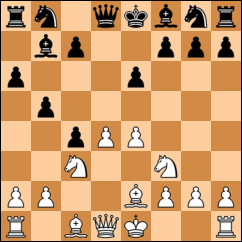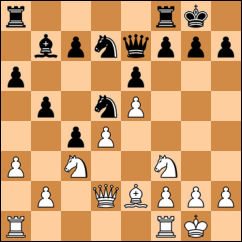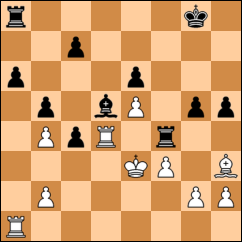K.Ammann–S.McWhirter
Route 20 Chess Club
Freeport, Ill., July 13, 2010

1.d4 d5 2.c4 dxc4 3.Nf3 b5
"I always feel like it's a good idea to get out of book," Steve says, "even though I'm not sure what book is." In this case, the main line is 3...Nf6, with 3...a6, 3...c5 and 3...e6 as frequently attempted sidelines.
4.e4
Seizing the center but missing the retort that refutes 3...b5, which is 4.a4 c6 5.e3 e6 6.axb5 cxb5 7.b3, bloodily regaining the pawn and blowing black's queenside wide open. Not taking on the b-pawn -- and thus remaining a pawn down -- plants the seed of disadvantage that will grow to entangle me.
4...Bb7 5.Nc3 a6 6.Be2 e6

7.a3
Here I'm worrying about ...Bb4 coming in and taking out my vital queen's knight, without which my e-pawn falls. In actuality, though, my fear is exaggerated: 7.0-0 Bb4 8.a4 Bxc3 9.bxc3 Bxe4 10.Ne5 leaves me two pawns down but with the bishop pair, an advanced knight and the makings of a strong attack, whereas if Steve simply plays for development, e.g., 7.0-0 Nf6 8.Qc2 c5 9.dxc5 Bxc5, his position is the stronger one.
7...Nf6 8.e5 Nd5 9.Bg5 Be7 10.Qd2 0-0 11.Bxe7
Despite being down a pawn, I decide it's worth my while to trade my bad bishop for Steve's good one.
11...Qxe7 12.0-0 Nd7
13.Nxd5
This, however, is not a good trade for me. Once again, I'm worrying excessively about the safety of my queen's knight. But the greater threat from Steve is that he's going to hit my center pawns with ...f6 or ...c5. My best choice here is 13.a4.
13...Bxd5
Not 13...exd5, which gives me chances on the e-file.
14.Qb4
Another foolish throwaway trade. 14.a4 is still an option, but not for much longer.
14...Qxb4 15.axb4 f6 16.Rfd1
I should be considering 16.Ra3, preparing to double my rooks on the a-file.
16...fxe5 17.dxe5 Nb8
17...c5!? begins to present itself as particularly powerful: 18.bxc5 Nxc5 19.Nd4 is strong for black.
18.Nd4 Nc6
Allows a trade that opens up the d-file for my rook . . .
19.Nxc6 Bxc6 20.Bg4 Bd5
. . . which I promptly squander.
21.f3 g6
I see the Noah's Ark trap coming and take measures to prevent it. Actually, I don't mind this so much, since my idea behind 21.f3 is to march my king over to the opposite side and start taking out vulnerable pawns. But to do that, I have to get Steve's bishop off the long diagonal somehow.
22.Kf2 h5 23.Bh3 Rf4 24.Ke3 g5 25.Rd4!?
Steve is taken aback by this in-your-face move. Rather than trade rooks, he backs off.
25...Rf7 26.Rd2
Not sure what else to do, I pull back too. A beautiful opportunity missed: As Gary Sargent points out after the game, 26.Rxd5! exd5 27.Be6 Kf8 (27...c6 28.Kd4 Kf8 29.Bxf7 Kxf7) 28.Bxf7 Kxf7 clears the path for my king to invade on the queenside, just as I'd hoped to do.
26...Rg7
Cocking for another shot.
27.g4
A significant stumble. The counterintuitive move 27.Bf5!, aiming at 28.Be4, challenges black's control of the long diagonal; if 27...exf5? 28.Rxd5 with a cleared diagonal and a passed pawn.
27...h4 28.Bg2 Rf7 29.h3 Bb7 30.Rd4 Raf8 31.Rf1 Rc8 32.Rd2?
And here's the mistake that's going to cost me the game once and for all. 32.Rfd1, doubling rooks for a direct attack, is my only shot at counterplay.
32...c5 33.f4
33.bxc5 Rxc5 34.f4 Bxg2 35.Rxg2 Rxe5+ 36.fxe5 Rxf1 is better, but not enough.
33...Bxg2 34.Rxg2 Rxf4 35.Rxf4 gxf4+ 36.Kxf4 cxb4 37.Rd2
Hastens the inevitable.
37...c3 38.Rc2 b3 0-1
Seeing how I'm about to get pwned, I resign.






0 comments:
Post a Comment